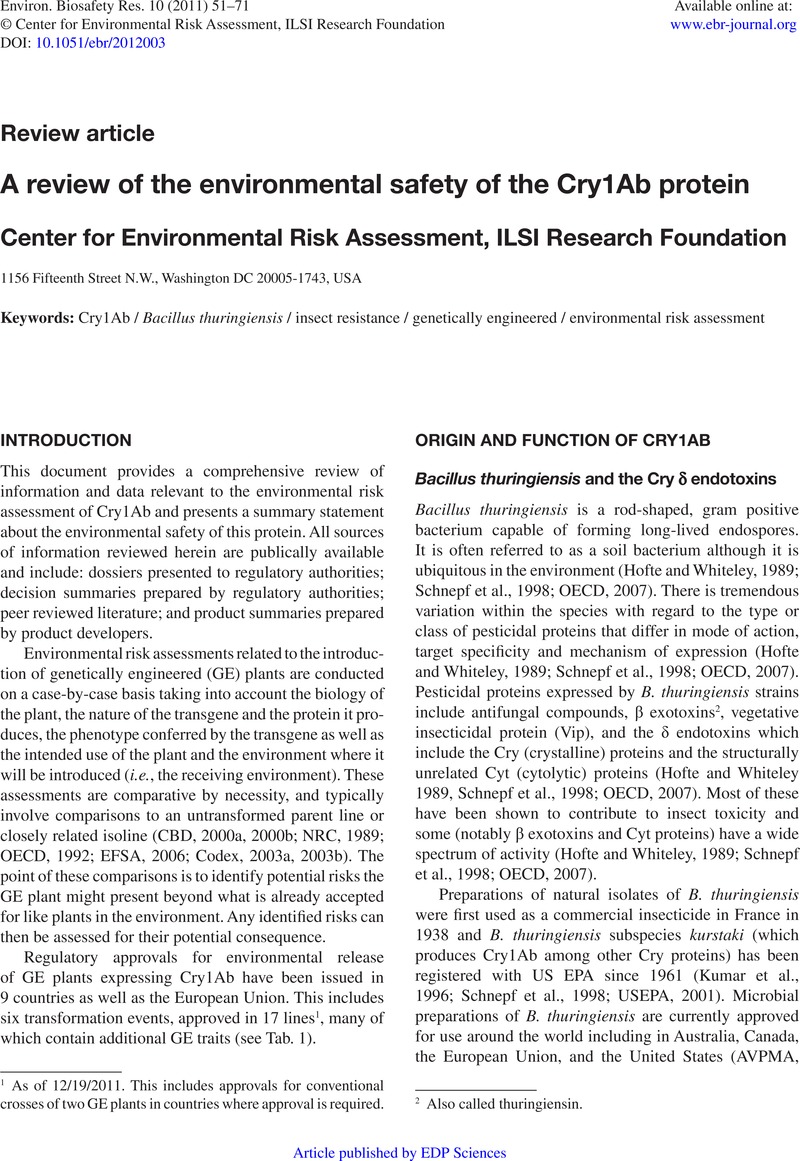Crossref Citations
This article has been cited by the following publications. This list is generated based on data provided by Crossref.
Garcia-Alonso, Monica
Hendley, Paul
Bigler, Franz
Mayeregger, Edgar
Parker, Ronald
Rubinstein, Clara
Satorre, Emilio
Solari, Fernando
and
McLean, Morven A.
2014.
Transportability of confined field trial data for environmental risk assessment of genetically engineered plants: a conceptual framework.
Transgenic Research,
Vol. 23,
Issue. 6,
p.
1025.
Roberts, Andrew
Devos, Yann
Raybould, Alan
Bigelow, Patrick
and
Gray, Alan
2014.
Environmental risk assessment of GE plants under low-exposure conditions.
Transgenic Research,
Vol. 23,
Issue. 6,
p.
971.
Tian, Jun-Ce
Yao, Ju
Long, Li-Ping
Romeis, Jörg
and
Shelton, Anthony M.
2015.
Bt crops benefit natural enemies to control non-target pests.
Scientific Reports,
Vol. 5,
Issue. 1,
Devos, Yann
Ortiz-García, Sol
Hokanson, Karen E.
and
Raybould, Alan
2018.
Teosinte and maize × teosinte hybrid plants in Europe−Environmental risk assessment and management implications for genetically modified maize.
Agriculture, Ecosystems & Environment,
Vol. 259,
Issue. ,
p.
19.
Roberts, Andrew
Boeckman, Chad J.
Mühl, Marina
Romeis, Jörg
Teem, John L.
Valicente, Fernando H.
Brown, Judith K.
Edwards, Martin G.
Levine, Steven L.
Melnick, Rachel L.
Rodrigues, Thais B.
Vélez, Ana M.
Zhou, Xuguo
and
Hellmich, Richard L.
2020.
Sublethal Endpoints in Non-target Organism Testing for Insect-Active GE Crops.
Frontiers in Bioengineering and Biotechnology,
Vol. 8,
Issue. ,
McDonald, Justin
Burns, Andrea
and
Raybould, Alan
2020.
Advancing ecological risk assessment on genetically engineered breeding stacks with combined insect-resistance traits.
Transgenic Research,
Vol. 29,
Issue. 1,
p.
135.
Vieira, Leonardo
Hissa, Denise Cavalcante
Souza, Terezinha
Gonçalves, Íris Flávia Sousa
Evaristo, Joseph Alberto Medeiros
Nogueira, Fábio César Sousa
Carvalho, Ana Fontenele Urano
and
Farias, Davi
2021.
Assessing the effects of an acute exposure to worst-case concentration of Cry proteins on zebrafish using the embryotoxicity test and proteomics analysis.
Chemosphere,
Vol. 264,
Issue. ,
p.
128538.
O. Magomer, Titus
K. Ngugi, Eliud
I. Shibair, Solomon
and
Mutitu, Eunice
2022.
Comparative Effect of Bacillus thuringiensis Endotoxins on the Fitness of F1 Sorghum×Weed Hybrids.
Biotechnology(Faisalabad),
Vol. 21,
Issue. 1,
p.
30.
Avisar, Dror
Manoeli, Alexandre
dos Santos, Anselmo Azevedo
Porto, Antonio Carlos Da Mota
Rocha, Carolina Da Silva
Zauza, Edival
Gonzalez, Esteban R.
Soliman, Everton
Gonsalves, José Mateus Wisniewski
Bombonato, Lorena
Galan, Maria P.
Domingues, Maurício M.
Candelaria, Murici Carlos
Mafia, Reginaldo
Graça, Rodrigo Neves
Azulay, Shelly
Livne, Sivan
Dias, Tatiane Buono
Drezza, Thaís Regina
Silva, William Jose
and
Pinheiro, Ana Cristina
2024.
Genetically engineered eucalyptus expressing pesticidal proteins from Bacillus thuringiensis for insect resistance: a risk assessment evaluation perspective.
Frontiers in Bioengineering and Biotechnology,
Vol. 12,
Issue. ,





